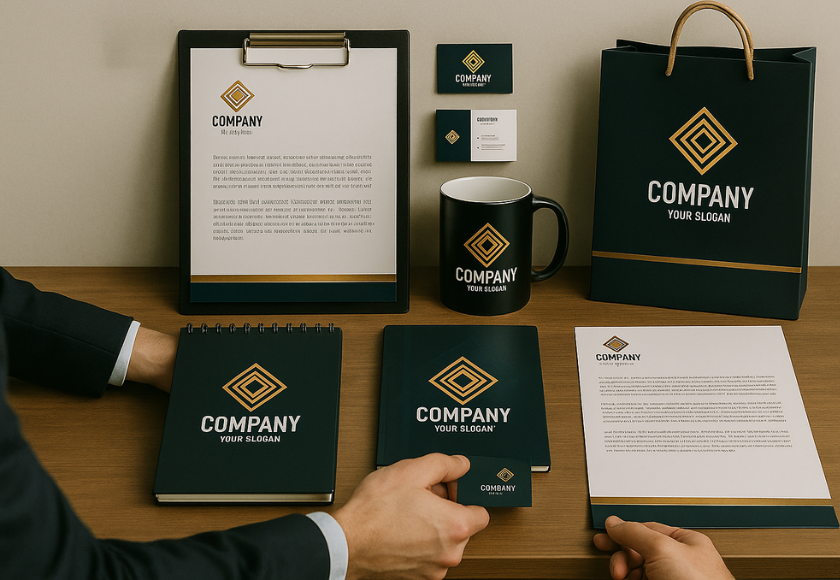Visual Identity and Design
Branding > Visual Identity & Design
Craft a Visual Identity That Connects
We create brand-aligned visual identities and design systems that communicate clearly, build trust, and make your business unmistakably recognizable.
Strategy-Led Design
Every line, font, and color supports a defined brand goal.
Scalable Systems
Designs built to grow across touchpoints and platforms.
Clarity Over Clutter
Minimal, bold, and memorable — always.
Why Choose Us
Design Rooted in Brand Strategy
We align every design element with your brand’s core values and goals — from logos to layouts, we build cohesive visuals that deliver business impact.
“ They didn’t just design — they distilled our brand into something unforgettable.”
Noura K.

Complete Visual Identity System
We develop logo suites, color palettes, type hierarchies, and layout rules that stay true to your brand story while ensuring consistency across every channel.
- Logo + palette creation
- Layout system build

Brand-Aligned UX/UI Design
We translate your identity into intuitive interfaces and digital designs that are user-friendly, visually stunning, and built for conversion.
- Intuitive layouts
- Brand-driven UX
Our Services
Explore Our Visual Design Specialties
From brand books to UI systems, our visual identity services ensure every design asset aligns with your business strategy and communicates your essence.

Logo Design Systems
Create versatile logo suites for every format, screen, and medium.

Brand Color Palettes
Establish cohesive color systems that evoke emotion and recognition.

UI/UX Design
Craft intuitive, aesthetic digital interfaces that reflect your identity.

Brand Guidelines Creation
Document your visual identity rules for use across teams and vendors.

Social Media Templates
Branded assets for consistent content across all social platforms.

Motion & Animation Design
Bring your brand to life with short-form animations and visual storytelling.
Visual Identity & Design
Visual Identity & Design: Shaping the Soul of Modern Brands
In the modern digital-first landscape, a brand’s visual identity is far more than just a collection of aesthetic choices. It is the visual embodiment of its character, values, and mission. From the first point of contact to every subsequent brand interaction, visual design dictates perception, influences trust, and defines emotional resonance. Visual identity and design stand at the core of every touchpoint, whether it’s a startup introducing itself to the world or an established enterprise reinforcing its position. This isn’t merely about logos or color palettes—it’s about coherence, consistency, and intentional storytelling. A strategically designed visual identity not only captures attention but also nurtures loyalty and delivers a lasting competitive advantage in saturated markets.
Defining Visual Identity in the Brand Ecosystem
Visual identity is the collective visual language that represents a brand across various mediums. It’s an integrated system of components including logo marks, typography, color systems, imagery, layout structures, and design motifs. These elements are not created in isolation but designed to work in concert, forming a unified presentation that reflects the brand’s personality and differentiates it from competitors. Whether digital or physical, print or motion, each application of the visual identity reinforces brand recognition, ensuring that audiences experience familiarity regardless of where or how they engage with the business.
What separates good visual identity from great is strategic alignment. Every design choice should support the brand’s promise, tone, and audience expectations. This means that a luxury brand should exude sophistication and minimalism through refined typography and restrained palettes, while a tech-forward startup may adopt bold geometries, vibrant hues, and kinetic motion graphics to express innovation and energy. The semantics of design—how each visual cue communicates meaning—is vital. It’s not simply about looking good, but about being unmistakably, recognizably aligned with the brand’s deeper narrative.
The Strategic Process Behind Visual Identity Design
Developing a successful visual identity requires a thorough and deliberate process rooted in strategy, not guesswork. It begins with brand discovery—an immersive stage that involves understanding the brand’s mission, its competitive landscape, user personas, and business objectives. This insight-gathering phase sets the foundation, revealing what the identity must express and to whom it must appeal. With this foundation in place, concept development begins. Designers synthesize strategic input into visual territories, exploring how forms, colors, and typography can tell a coherent story. These explorations are refined through iteration and critique, ensuring alignment with brand strategy at every step.
The process also involves rigorous testing. Identity concepts must function across all intended environments—from large-scale signage to mobile screens and digital ads. Scalability, legibility, contrast ratios, and adaptive behaviors all come into play. Furthermore, the application must be consistent yet flexible, allowing for variation while maintaining brand integrity. A brand operating globally may require visual systems that accommodate language translations and cultural variations without sacrificing core identity. Design systems must therefore be robust enough to maintain consistency, yet modular enough to adapt fluidly across use cases.
The Core Components of Visual Design Systems
At the heart of any visual identity is the logo—the brand’s emblematic signature. A well-conceived logo distills the essence of the brand into a visual mark that is both distinctive and enduring. However, the logo is only one element of a broader system. Typography serves as the brand’s voice, delivering messages with tone and personality. Font choices can suggest authority, friendliness, elegance, or innovation depending on the design language and pairing.
Color theory plays a powerful psychological role in identity systems. Brands choose colors not just for aesthetic purposes but for the emotions and cultural signals they evoke. Red, for example, might express passion or urgency, while blue often suggests reliability and calm. These colors are codified into primary and secondary palettes, guiding usage in web interfaces, print materials, and product packaging. Imagery and iconography extend the brand story further, capturing lifestyle, culture, and context through visual storytelling. Patterns, textures, and layout systems establish visual rhythm, ensuring every composition feels like part of a larger, interconnected world.
Photography style is also critical. Whether documentary-style images that convey authenticity or highly curated visuals that exude premium quality, photography influences how users emotionally relate to the brand. Cohesiveness in image selection, composition, lighting, and post-processing defines a brand’s visual editorial tone. Combined, these design components form a comprehensive visual language that speaks consistently across every touchpoint.
Building Design Systems for Scalability and Governance
Creating a visual identity is not a one-time event—it is the beginning of an evolving relationship between brand and audience. For the identity to scale effectively, it must be supported by a robust design system. Design systems define the rules, constraints, and best practices that govern how the identity is applied. These systems ensure that as the brand grows, the visual language can be consistently reproduced across products, regions, and teams. Central to this effort is the brand style guide, a living document that outlines logo usage, color codes, typography hierarchy, layout grids, spacing rules, and motion guidelines.
In an increasingly decentralized and collaborative world, governance is essential. Companies must equip both internal teams and external partners with tools and assets that facilitate brand consistency. This often includes digital asset libraries, templated design kits, and cloud-based collaboration platforms. A well-governed design system empowers teams to create with confidence while preserving visual coherence. It enables rapid innovation without compromising identity integrity, ensuring that the brand experience remains unified across customer journeys.
The Role of Visual Identity in Digital and Physical Experiences
Today’s brands must exist fluidly across both digital and physical environments. Visual identity plays a critical role in shaping user experiences across websites, apps, social media, retail stores, packaging, and advertising. In digital spaces, responsive design and user interface patterns dictate how identity elements behave on various screens. Animations and transitions bring personality and interactivity, extending the brand into motion. Every pixel must reinforce the brand story, from the hover states on buttons to the transitions between pages.
In physical environments, signage systems, packaging materials, uniforms, and event displays transform the identity into tangible encounters. Here, tactile qualities like material finishes, print techniques, and environmental graphics add sensory dimensions that digital design cannot replicate. When these experiences are coordinated—when the website feels like the store, and the packaging echoes the social feed—the brand achieves omnichannel alignment. This reinforces trust and increases customer loyalty, as the brand becomes a familiar and reliable presence in the consumer’s life.
Measuring the Impact of Visual Identity on Brand Equity
While the outcomes of visual identity can feel intangible, their impact on brand performance is measurable. Recognition, recall, preference, and trust are all influenced by the strength and consistency of visual identity. Brand tracking studies can assess changes in awareness and perception pre- and post-rebrand. Digital metrics like engagement rates, conversion performance, and user experience scores provide insights into how well the identity supports business objectives. Social listening tools can track sentiment and visual content interactions to evaluate resonance and alignment.
Brands that invest in high-quality visual design often outperform peers in customer loyalty, share of voice, and revenue growth. The clarity and consistency offered by a strategic visual identity improve marketing effectiveness by reducing friction in user journeys and enhancing emotional appeal. Over time, a well-constructed identity becomes a strategic asset—one that drives differentiation, reinforces positioning, and strengthens competitive advantage.
Evolving Identity in Response to Growth and Change
Visual identity is not static. As markets evolve and businesses mature, identities must adapt. Rebrands, refreshes, and visual updates are natural stages in a brand’s lifecycle. Whether prompted by a shift in strategy, expansion into new markets, or evolving audience expectations, identity evolution should be approached with care. This process involves retaining the equity built through existing assets while modernizing elements to reflect current realities.
Brands must strike a balance between continuity and change. Abrupt or unconsidered identity changes can confuse loyal audiences or dilute equity. A well-managed evolution preserves recognizability while signaling progress. This might involve refining a logo, updating type systems for digital legibility, or expanding color palettes to reflect greater inclusivity. Continuous testing and audience feedback are critical throughout this process, ensuring that visual shifts enhance rather than detract from brand relevance.
Visual Identity as a Strategic Investment
A brand’s visual identity is not merely an output of design—it is a strategic framework that defines how the brand shows up in the world. It influences perception, drives engagement, and forms the foundation for lasting relationships with customers. When developed with intention and governed with consistency, visual identity becomes a competitive advantage that scales with the business. It enables every campaign, product, and interaction to build upon a coherent narrative, creating a brand that is not only seen—but remembered, respected, and trusted. For any business ready to elevate its presence, investing in strategic visual identity and design is not optional—it is essential.
Let's get started
Don't get left behind
Stay ahead of the competition with ReachOut – don’t get left behind.

Got a question? Get your answers
Quick answers to questions you may have. Can’t find what you’re looking for? Check out our full documentation.
01. What is visual identity and why does it matter?
Visual identity is the mix of logo, colors, fonts, and imagery that people see first. It acts like your brand’s face, sparking instant recognition and trust. Without a clear look, you blend into the crowd and get forgotten fast.
02. How is visual identity different from overall branding?
Branding covers the whole story—mission, voice, customer experience. Visual identity is just the look-and-feel layer that makes the story visible. Think of it as the outfit, not the personality.
03. What elements are must-haves for a strong visual identity?
You need a scalable logo, a defined color palette, and a consistent font stack as the core. Add supporting graphics, icon style, and imagery rules to round things out. Together they form a style guide everyone can follow.
